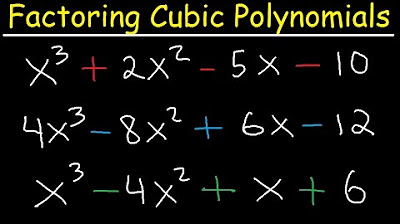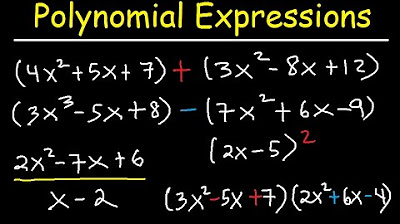TAGALOG: Division of Polynomials - Long Division and Synthetic Division #TeacherA
Summary
TLDRIn this educational video, Teacher A introduces lesson 99 on the division of polynomials, focusing on the long division and synthetic division methods. The video provides a step-by-step guide to dividing polynomials, starting with arranging terms in descending order of powers. Example problems are solved to demonstrate each method, showing how to divide polynomials like 'x^2 - 2x - 8' by 'x - 4' using both techniques. The video concludes with a call to action for viewers to join Teacher A's community for more educational content.
Takeaways
- 📚 The lesson focuses on division of polynomials, specifically using long division and synthetic division methods.
- 🔢 The first example demonstrates long division of the polynomial x^2 - 2x - 8 by x - 4, resulting in the quotient x + 2.
- 📉 In the long division process, the first step is to arrange the dividend in descending order of powers, followed by the division symbol and the divisor.
- ➗ The division of the first terms (leading coefficients) is performed, and the result is multiplied by the divisor and subtracted from the dividend.
- 🔄 This process of dividing, multiplying, and subtracting is repeated until the degree of the remaining polynomial is less than the divisor.
- 📈 Synthetic division is introduced as an alternative method for dividing polynomials, particularly useful for finding specific roots.
- 📝 For synthetic division, coefficients of the dividend are aligned, and the divisor's root is used to successively calculate new coefficients and the remainder.
- 🔎 The second example illustrates the long division of 3x^3 + 7x^2 + 3x + 2 by x + 2, yielding a quotient of 3x^2 + x + 1 and a remainder of 0.
- 🔄 Similar to the first example, the synthetic division for the second polynomial also results in a quotient of 3x^2 + x + 1 with no remainder.
- 👨🏫 The instructor, Teacher A, invites viewers to join the community for updates on more educational content.
Q & A
What is the main topic of the lesson presented in the transcript?
-The main topic of the lesson is the division of polynomials, specifically focusing on the long division method and synthetic division.
What is the first example given in the lesson to demonstrate the long division method?
-The first example is the division of the polynomial x^2 - 2x - 8 by x - 4.
How does the teacher instruct to start the long division of polynomials?
-The teacher instructs to start by arranging the dividend in descending order of powers and then dividing the first terms of the polynomial.
What is the role of the divisor in the long division method as described in the transcript?
-The divisor is used to divide the first term of the dividend, and then it is multiplied by the result to be subtracted from the next term in the dividend.
What is the result of the first example using the long division method?
-The result of the first example using the long division method is x + 2.
How does synthetic division differ from the long division method as explained in the transcript?
-Synthetic division is a shortcut method for dividing polynomials that involves fewer steps and is used when the divisor is of the form x - c, where c is a constant.
What is the significance of the divisor being x - 4 in the synthetic division example?
-The significance is that it allows for the use of synthetic division, which is more efficient than long division when the divisor is linear and of the form x - c.
What is the process for performing synthetic division as described in the transcript?
-The process involves arranging the coefficients of the dividend in descending order, using the zero of the divisor to find the remainder, and then performing a series of multiplications and additions to find the coefficients of the quotient.
What is the result of the first example using synthetic division?
-The result of the first example using synthetic division is also x + 2, which matches the result obtained by the long division method.
What is the second example given in the lesson to demonstrate the long division method?
-The second example is the division of the polynomial 3x^3 + 7x^2 + 3x + 2 by x + 2.
How does the teacher ensure that the subtraction of polynomials is correctly performed in the long division method?
-The teacher ensures correct subtraction by emphasizing the importance of changing the sign of the terms when they are subtracted and following the rules of polynomial subtraction.
Outlines

This section is available to paid users only. Please upgrade to access this part.
Upgrade NowMindmap

This section is available to paid users only. Please upgrade to access this part.
Upgrade NowKeywords

This section is available to paid users only. Please upgrade to access this part.
Upgrade NowHighlights

This section is available to paid users only. Please upgrade to access this part.
Upgrade NowTranscripts

This section is available to paid users only. Please upgrade to access this part.
Upgrade NowBrowse More Related Video

Factoring Cubic Polynomials- Algebra 2 & Precalculus

Polynomials - Adding, Subtracting, Multiplying and Dividing Algebraic Expressions

Pembagian suku banyak dengan cara bersusun - Menentukan hasil dan sisa pembagian

Synthetic Division of Polynomials

Polinomial (Bagian 3) - Pembagian Polinomial Cara Bersusun, Horner dan Horner - Kino

Long Division | How to Divide Polynomials | Grade 10 Math @MathTeacherGon
5.0 / 5 (0 votes)